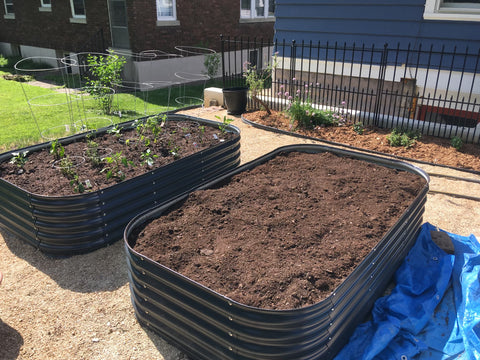Growing Sunshine: Tips for Planting Sunflower Seeds in a Raised Garden Bed
There's something truly magical about the bright and cheerful presence of sunflowers in a garden. Their vibrant colors and towering stalks not only add beauty but also attract pollinators, making them a wonderful addition to any raised garden bed . If you're considering planting sunflowers in your raised garden bed , here are some valuable tips to ensure a successful and joyful sunflower-growing experience.
1.Select the Right Sunflower Varieties:
Before you start planting, choose sunflower varieties that are well-suited for raised garden bed ing. Dwarf or compact sunflower varieties are excellent choices as they won't overshadow other plants and are better equipped to thrive in confined spaces.
2.Choose a Sunny Spot:
As the name suggests, sunflowers love sunlight. Ensure your raised bed receives at least 6 to 8 hours of direct sunlight daily. Position your raised bed where it can bask in the sun, promoting healthy and robust sunflower growth.
3.Prepare the Soil:
Sunflowers prefer well-draining soil with a slightly acidic to neutral pH. Prepare your raised bed by mixing in compost to enhance soil fertility. Loose, rich soil will allow sunflower roots to spread easily, promoting optimal nutrient absorption.
4.Planting Depth and Spacing:
Sow sunflower seeds one to one and a half to two inches deep. Follow the recommended spacing for your chosen sunflower variety to avoid overcrowding. Sufficient distances guarantee appropriate ventilation and lower the likelihood of illnesses.
5.Watering:
Sunflowers are relatively drought-tolerant, but consistent watering is crucial, especially during the germination and early growth stages.Keep the soil in the raised bed constantly moist but not soggy by giving it regular waterings. Once established, sunflowers can tolerate drier conditions.
6.Provide Support for Taller Varieties:
If you've opted for taller sunflower varieties, consider providing support to prevent the stems from bending or breaking. Install stakes or a trellis system in your raised bed to support the growing sunflowers, particularly in areas prone to strong winds.
7.Mulching:
Apply a layer of mulch around the sunflowers to help retain soil moisture, suppress weeds, and regulate soil temperature. Organic mulches, such as straw or shredded leaves, are excellent choices for raised garden beds.
8.Fertilize Wisely:
While sunflowers aren't heavy feeders, providing them with a balanced fertilizer during the growing season can encourage healthier and more robust growth. Follow the package instructions and avoid over-fertilizing, as excessive nutrients can lead to tall, spindly plants.
9.Deadheading:
Deadhead (remove spent flowers) frequently to promote continual blooming. This prevents the plant from directing energy towards seed production, promoting the development of new blooms.
10.Enjoy the Harvest:
As your sunflowers grow and bloom, take the time to appreciate their beauty and the wildlife they attract. Once the flowers have matured, you can harvest the seeds for snacks or leave them for birds to enjoy.
In conclusion, planting sunflowers in a raised garden bed can be a rewarding and visually stunning experience. By following these tips, you'll be well on your way to cultivating a vibrant garden full of these sunny delights. Happy gardening!


